
A Caveat
Protein Level in the Food
The most important variable when choosing a fish food is the protein level. The higher the protein level in any food the healthier the fish. But this effect is NOT because eating high protein food is good for a fish. Rather the effect is due to what high protein food can do to the ecosystem that is in any aquarium. Higher protein food is a significant factor in creating crystal clear water. In turn, crystal clear water gives very healthy fish.
Note I personally simply buy the highest protein level I can find if I need to buy commercial pelleted fish food.
But it should also be noted that the BEST food is both homemade and Mazuri gel foods. Both of these are roughly 55% protein with very low carbohydrates. More information can be found in this article:
3.4. Homemade Gel Foods
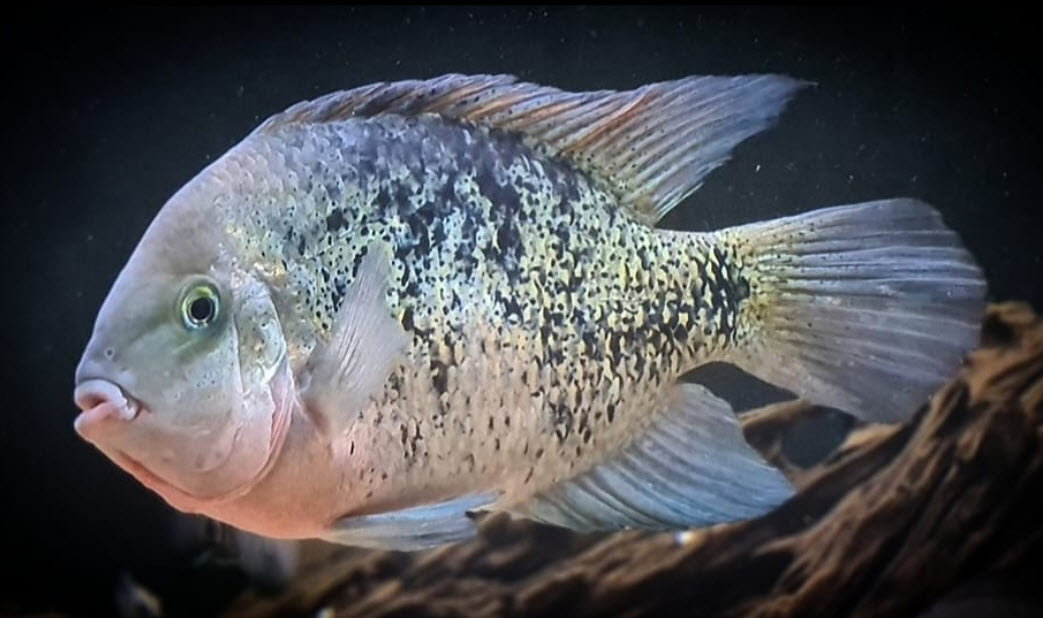
Low protein food does not directly produce unhealthy fish. Rather its effect is indirect, through a long line of causal effects:
- A low protein food has a high carbohydrate content
- Carbohydrates are only 50% digested by the fish
- The undigested carbohydrates create dissolved organic compounds (DOCs) that have a high carbon to nitrogen ratio
- Pathogenic bacteria and other pathogenic organisms proliferate with high carbon to nitrogen ratio DOCs
- The proliferation of these organisms in the water column results in “dull” or even slightly milky water
- These pathogenic bacteria and other organisms in the water column attack the fish
Now everyone wants to know what defines a low protein food. I make the cut-off at 45% for dry commercial fish food. But the “45% protein” level is completely arbitrary. In truth there is a continuum between 30% and 60%. A level of 42% protein in the dry commercial fish food won’t be “ideal” but it also won’t be that bad. The key is the clarity of the water. Is the 42% protein food giving crystal clear water? Or is it giving “dull” water or even slightly cloudy water. There is a “threshold” here.
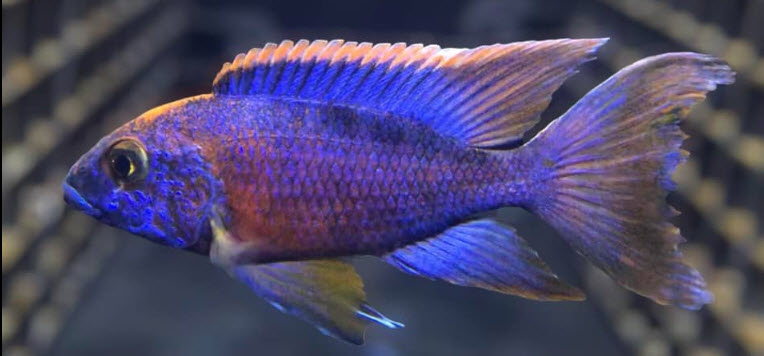
But where the threshold will be is very dependent on a multitude of variables. For instance, 34% might give crystal clear water in one aquarium setup while 52% might give “dull” water in another aquarium setup. Note that if I must buy commercial fish food, I ALWAYS buy the highest protein level I can find.
Below I will discuss those food variables that directly affect the fish. This is with the clear understanding that all these effects are minor compared to the effect of the protein level on the health of the fish via the creation of a pathogen filled water column.
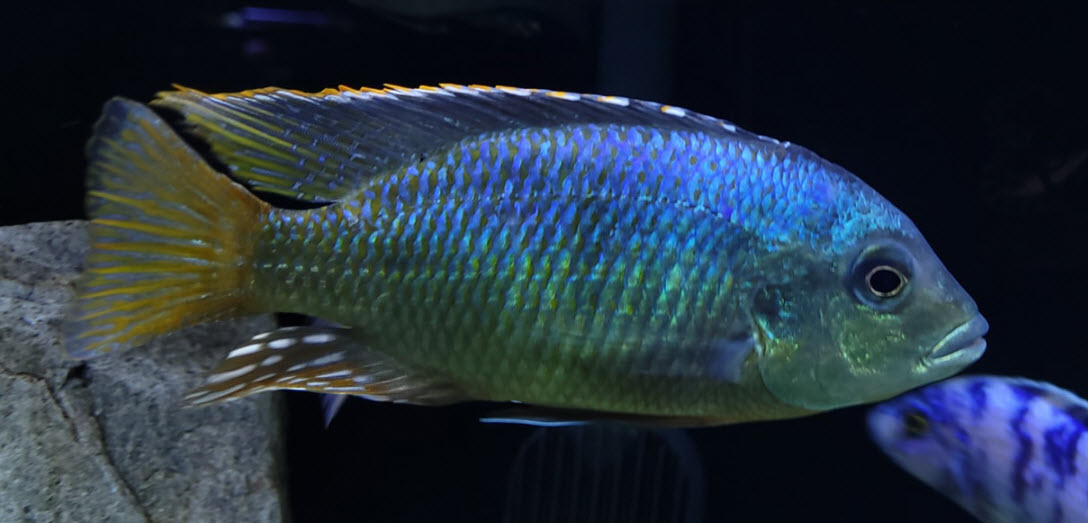
Fish Food Quality
Research has shown little or no effect on life expectancy or the health of the fish with various fish diets. There are four slightly desirable characteristics only:
- For optimum juvenile growth rate, have over 40% protein
- For optimum fertility, have over 10% fat
- For optimum juvenile growth rate, have less than 30% cheap protein from the likes of soybeans or gluten.
- For optimum growth rate in juveniles have “whole fish” or “fish meal” as one or more of the first few ingredients in fish food.
But it must be emphasized that this is all relative. Fish do just fine with food that is outside this range. All of the research found differences in the growth rate of juvenile fish and the fecundity of fish with foods at less than these levels. But the survival rates of the fish didn’t change with levels less than these “optimums”.
It should be noted that commercial tropical fish breeders in Florida buy their feed from commercial feed manufacturers who produce dry fish food in twenty-pound bags that meet the four levels above. These foods (save for the Purina feed) are not available to the home hobbyist.
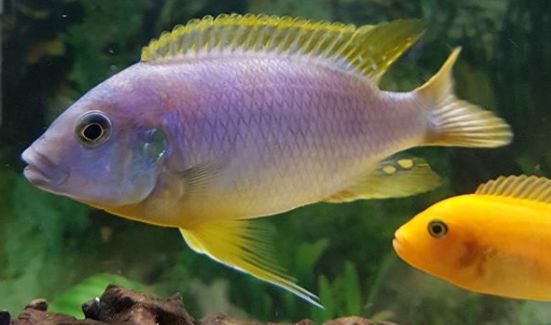
Quantity of Food Fed
The other reason for flexibility in food has to do with the quantity of food fed to tropical fish by hobbyists. Virtually all fish kept by hobbyists are fed a diet that has two to five times the food content of what the fish would be eating in the wild. Because of evolution and niche selection by species, fish in the wild live “on the edge” when it comes to food. In nature, there is fierce competition for food resources and each fish has evolved to survive on a very narrow band of specialized food input that is typically either quite low or very cyclic.
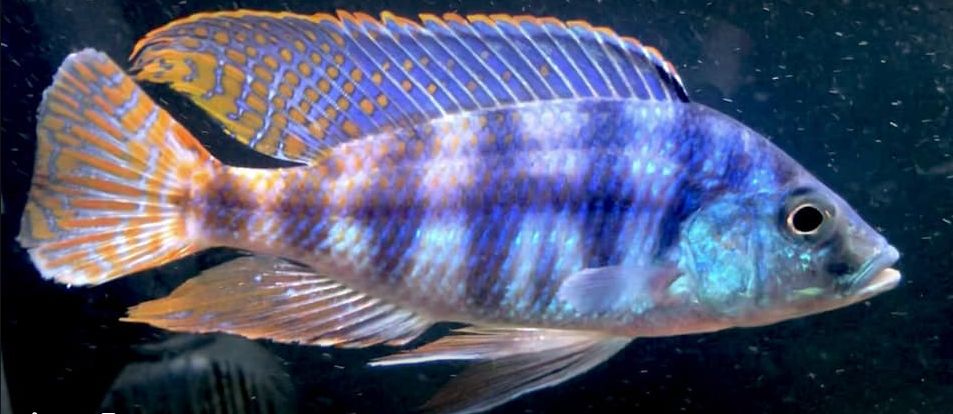
Fish Types and Food Requirements
Take a typical Malawi Hap. This Hap may have evolved to eat largely midge larvae in Lake Malawi, making him an “insectivore”, a type of “carnivore”. His food “input” per week might be 0.5 grams of animal protein and 0.1 grams of animal fat from these midges. His body has evolved to use this resource at its fullest potential. And many of his species don’t get this minimum input and thus don’t survive. This is simply Darwin’s “survival of the fittest” at work. If this Malawi Hap is given ONLY 0.5 grams of vegetable protein and 0.1 grams of vegetable fat from something like spirulina, the fish might well have health problems
Now put this fish in an aquarium and feed him a “herbivore” diet of spirulina pellets that give him 3 grams of vegetable protein and 0.4 grams of vegetable fat per week. This is six times the protein level of the native environment and four times the fat level. This fish will still prosper, despite being fed a “herbivore” diet. The aquarium is an artificial environment where the harsh rules of “Mother Nature” often don’t apply.
Herbivores, omnivores, and carnivores ALL do well on just about any diet from cheap flake and pellet food which is low in protein (~40%) and high in carbohydrate (~40%) to ground-up fish fillet that is 75% protein and 7% carbohydrate. There does seem to be a benefit from a vegetable or other source of roughage added once a week or so (something like “zucchini-a-la-fork”) but that evidence is anecdotal.
When it comes to vitamins and minerals none of the twelve book references (compendiums of literally thousands of research papers on fish nutrition) used for this article found any need for extra vitamins or minerals in any decent food for fish. All these references clearly said that virtually all the commercially available tropical fish foods will be just fine for any tropical fish, largely because of the large amount of food available in an aquarium at even 1% of a fish’s weight per day.
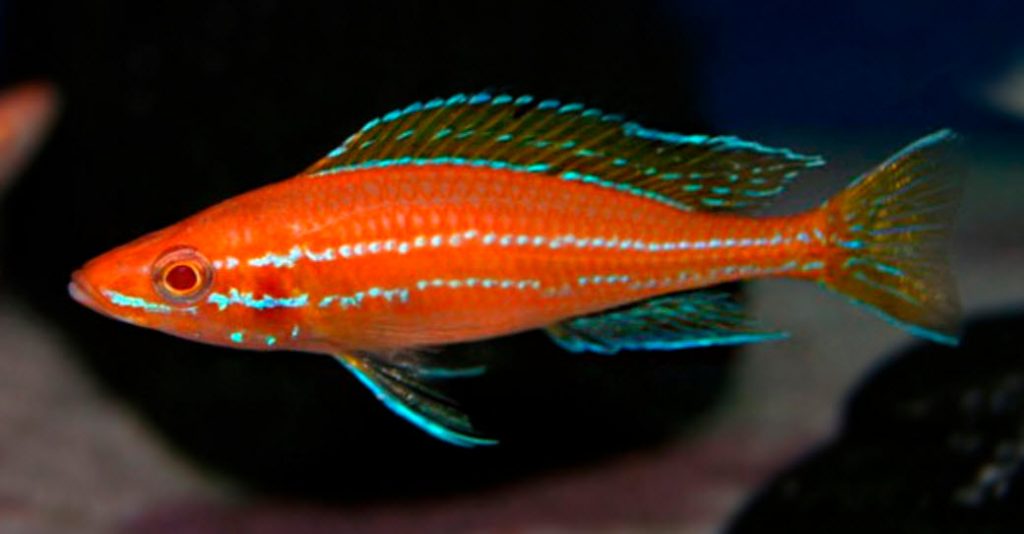
The “Best” Commercial Fish Food
Now every fish owner wants his fish to be in the best health possible. But research has shown little or no DIRECT effect on life expectancy or the health of the fish with various fish diets. As mentioned above, there are four slightly desirable characteristics only:
- For optimum juvenile growth rate, have over 40% protein
- For optimum fertility, have over 10% fat
- For optimum juvenile growth rate, have less than 30% cheap protein from the likes of soybeans
- For optimum growth rate in juveniles have “whole fish” or “fish meal” as one or more of the first few ingredients in fish food.
The protein level is more important than the fat level. But it must be emphasized that this is all relative. Fish do just fine with food that is outside this range. All of the research found differences in the growth rate of juvenile fish and the fecundity of fish with foods at less than these levels. But the survival rates of the fish and their health didn’t change with levels less than these “optimums”.
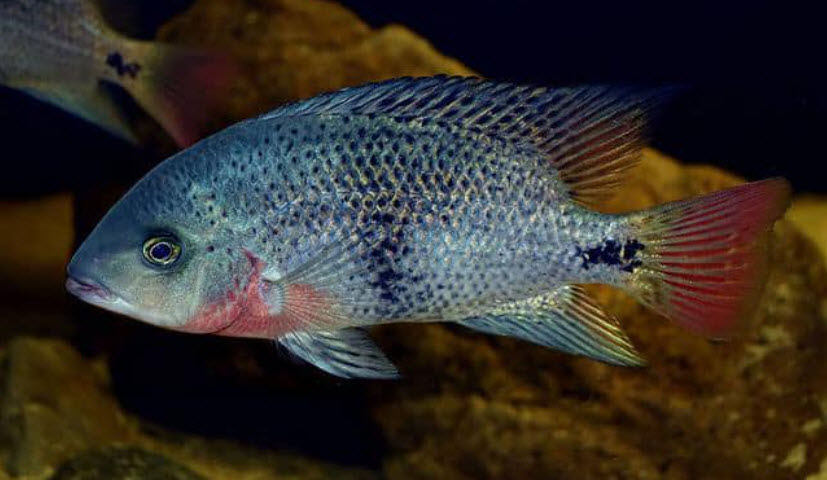
Here are some popular fish foods, rated by protein level. Obviously the Aquamax 500 is the best food.
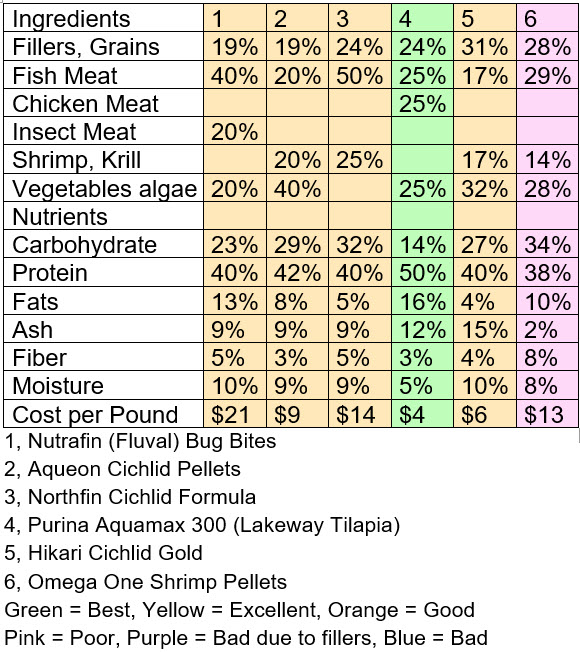
This chart is based on the protein level of the food
- Green best >50% protein
- Yellow excellent 45-49% protein
- Orange good 40-44% protein
- Pink poor 35-39% Protein
- Blue bad 30-35% protein
- Purple bad >50% filler
There are many more tables in this article:
3.6.1. Commercial Dry Fish Food
Note I did find a few fish foods (Sera) which had greater than 50% cheap fillers. I just don’t recommend buying these because I can’t see spending a lot of money for wheat, corn and potatoes. No logic, just being cheap.
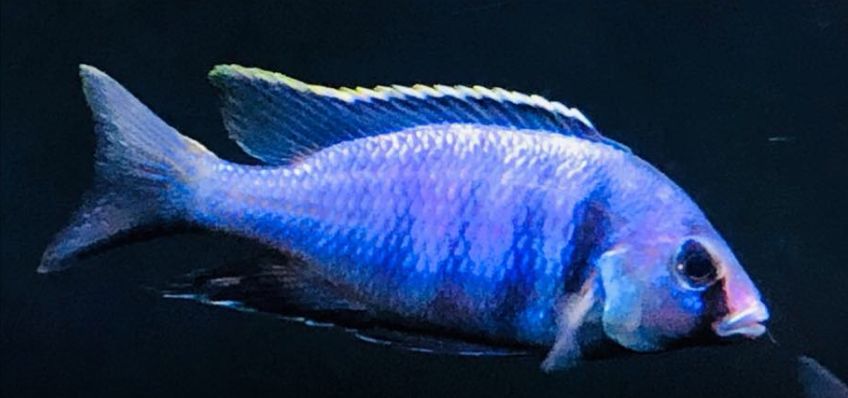
More Information
To see the science behind the above conclusions go to this link:
3.1.1. Fish Food Science
Many people want the “best possible” commercial dry food for their fish. So, an analysis of commercial fish food is in:
3.6. Commercial Dry Fish Food
If one wants to 100% control what their fish eat, one should use gel food. This is reviewed in this link:
3.4. Gel Fish Food
For those wanting more data on the many myths about fish food click on these links:
3.7. Banned Food
The myth of a correlation between high protein diets and Malawi Bloat is examined in this link:
3.8. Food and Malawi Bloat
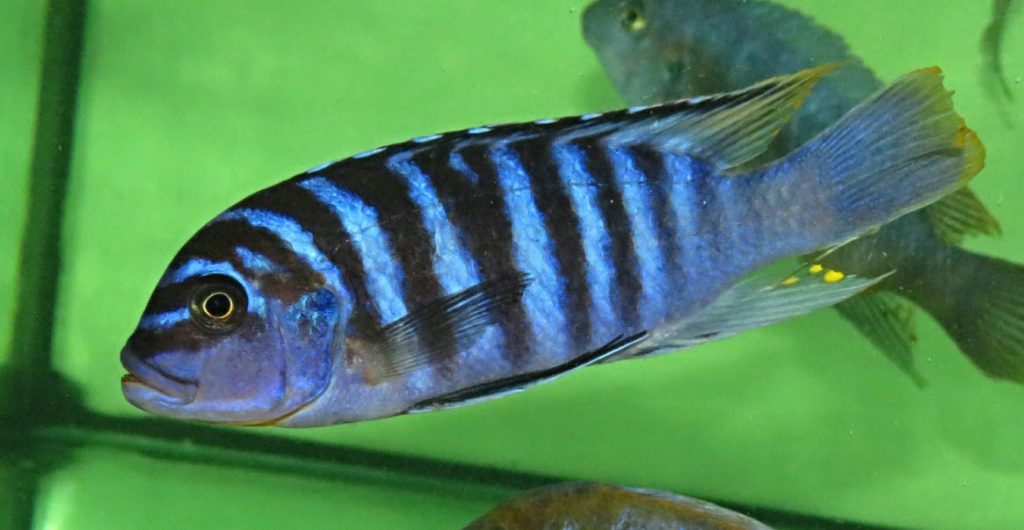
Return to Fish Food Menu
.
Aquarium Science Website
The chapters shown below or on the right side in maroon lead to close to 400 articles on all aspects of keeping a freshwater aquarium. These articles have NO links to profit-making sites and are thus unbiased in their recommendations, unlike all the for-profit sites you will find with Google. Bookmark and browse!
.

Leave a Reply